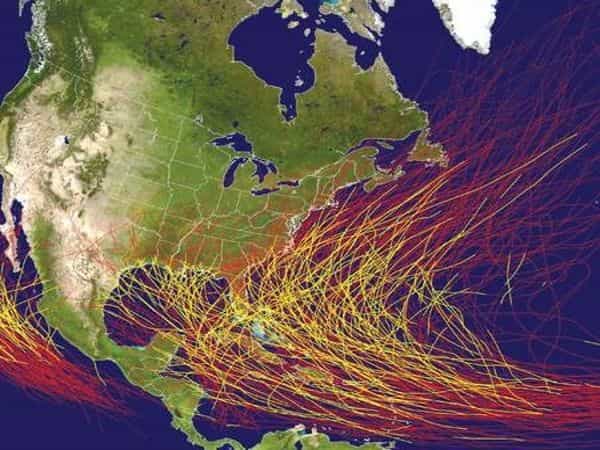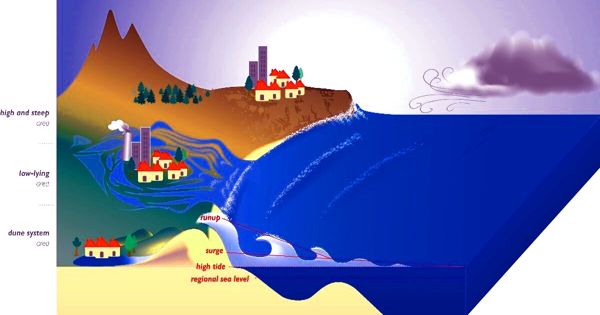Climate change and anthropogenic pressures are widely anticipated to exacerbate coastal hazards like episodic coastal flooding. Over the last two decades, the combination of sea-level rise, tides, storm surge, and waves has increased the overtopping of natural and artificial coastal protection by nearly 50%. This discovery is the result of an international study coordinated by IRD and involving international partners. The findings were published in the journal Nature Communications.
The researchers demonstrated that coastal overtopping, and thus the risk of flooding, is set to accelerate further in the twenty-first century, by up to 50-fold under a high-emission global warming scenario, particularly in the tropics, by combining satellite data and digital models. This rise is primarily the result of a combination of sea-level rise and ocean waves.
Unless effective flood mitigation strategies are implemented in the coming years, sea level rise is expected to at least double the frequency of coastal flooding in most locations around the world, potentially affecting millions of people living in low-lying coastal zones.
The combination of sea level rise, tides, storm surge and waves has increased the overtopping of natural and artificial coastal protection by nearly 50% in the last two decades.
Nearly 10% of the world’s population lives in low-lying coastal regions. In addition to ongoing erosion and rising sea levels, these areas and their unique ecosystems are threatened by destructive hazards such as episodic flooding caused by overtopping of natural/artificial protection, as in the case of Hurricane Katrina in the United States in 2005, Cyclone Xynthia in Europe in 2010, and Typhoon Haiyan in Asia in 2013. (the largest tropical cyclone ever measured).
These episodic events are expected to become more severe and frequent as a result of global warming, while the consequences, such as coastal and infrastructure development, will also increase as a result of increased anthropogenic pressure, such as rapid urbanization. Although the magnitude and frequency of these events are unknown, scientists believe tropical countries will be particularly affected.
Despite the important role that ocean waves play in determining coastal sea levels, their contribution to coastal flooding was previously overlooked, owing to a lack of accurate coastal topographic information.

Measuring past events to estimate future risks
In this study, French researchers from IRD, CNES, and Mercator Océan collaborated with colleagues from the Netherlands, Brazil, Portugal, Italy, and Nigeria to combine an unprecedented global digital model for surface elevation with new estimates of extreme sea levels. Tides, wind-driven waves, and existing measurements of natural and artificial coastal defenses are all included in these extreme water levels.
The researchers began by calculating the increase in global submersion events that occurred between 1993 and 2015. Satellite data was used to define two key parameters for coastal topography: the local beach slope and the maximum subaerial elevation of the coasts. The extreme level of coastal waters was calculated in hourly time-steps to determine the potential annual number of hours during which coastal defenses in each area could be breached.
“The main contributor to episodes of coastal overflow is the combination of tides and episodes of large waves,” says Rafal Almar, an IRD researcher in coastal dynamics and the study’s coordinator. “We identified hotspots, such as the Gulf of Mexico, the Southern Mediterranean, West Africa, Madagascar, and the Baltic Sea, where the risk of overtopping is increasing.”
Acceleration during the 21st century
The scientists also conducted an initial global assessment of potential coastal overtopping in the twenty-first century, taking into account various sea-level rise scenarios. According to the findings, the number of overtopping hours may increase faster than the average rate of sea-level rise. “Regardless of the climate scenario, the frequency of overtopping is increasing exponentially and will be clearly perceptible as early as 2050.” The intensity of the acceleration by the end of the century will be determined by future trajectories of greenhouse gas emissions and, as a result, sea-level rise.
“In the case of a high-emission scenario, the number of overtopping hours globally could increase fifty-fold compared to current levels,” warns Rafal Almar. “As the twenty-first century progresses, more and more regions will be exposed to overtopping and subsequent coastal flooding, particularly in the tropics, northwestern United States, Scandinavia, and Russia’s Far East.”
More research at the local and regional levels will be required to flesh out these global projections, which provide a solid foundation for proposing effective adaptation measures in the identified hotspots.














